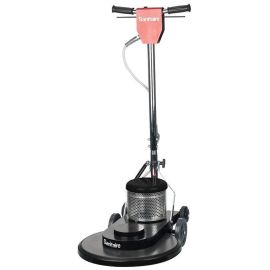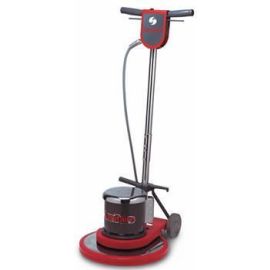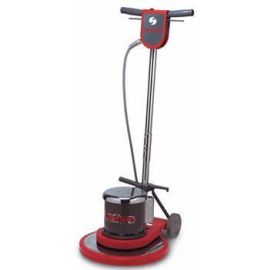Sanitaire Floor Machines

Best Sanitaire Floor Machines
Sanitaire’s floor machines are designed and built for safety, user comfort, and providing maximum shine to your hard surface floors, including hardwood, tile, linoleum, and marble. All models are made with the long-lasting enduring all-metal base, tubes, handles, and trigger assembled and designed for the ordeals of commercial cleaning. Models also come standard with a one-year warranty on labor as well as a three-year warranty on parts.
Models vary in diameter; however, they all offer the added feature of a safety shut-off switch. Although pad drivers are sold separately, you can easily change pads, or brushes to reinvigorate your hard surface flooring. Any of these models will bring out the luster of your hard surface floors, whether you’re cleaning, buffing or burnishing. For more information to find the right model, to add a little polish for your commercial use, contact us at ThinkVacuums either by email, chat or just call us at 1-800 322 2965.
Please Note: All Commercial Vacuums and Commercial Parts are Non-refundable
We have Live Sanitaire Experts Standing by Right Now at 1-800-322-2965
-
(PLEASE NOTE THE PAD DRIVER IS SOLD SEPARATELY) This Sanitaire CAST SC6010 Floor Machine is a very well reviewed machine. Sanitaire 6010 floor machines boast a superior chrome plated steel construction. Includes 50ft cord and on/off switch. For use on carpets and bare floors. Thi... Learn Moreabout Sanitaire CAST SC6010 Floor Machine 17in
-
(PLEASE NOTE THE PAD DRIVER IS SOLD SEPARATELY) The Sanitaire CAST SC6025 Floor Machine is a very well reviewed machine. Sanitaire Cast 6025 floor machines provide superior strength and high performance. They are built to last. All Sanitaire Floor Machines have chrome plated stee... Learn Moreabout Sanitaire CAST SC6025 Floor Machine 20in
-
(PLEASE NOTE THE PAD DRIVER IS SOLD SEPARATELY) Sanitaire CAST SC6045 floor machines s have chrome plated steel construction. They also feature 50-foot cords and safety shut off switches. The twin Capacitors allow for use on carpets and bare floors. This model is ideal for use i... Learn Moreabout Sanitaire CAST SC6045 Floor Machine 20in
-
Sanitaire SC6005 Floor Machine - DIscontinued - contact us for parts and accessories Learn Moreabout Sanitaire SC6005 Floor Machine
-
Sanitaire SC6015 Floor Machine, Powerful 1.5 hp motor / 14.9 amps / 175 brush rpm, Machine Size / brush size: 17 inch, Gearbox: 3 Idler, Cord Length: 50', Sound level at operator: 60 dB Learn Moreabout Sanitaire SC6015 Floor Machine
-
(PLEASE NOTE THE PAD DRIVER IS SOLD SEPARATELY) Features include a 50' cord, safety shut-off switch and multi-speed motors. Learn Moreabout Sanitaire CAST SC6030 Floor Machine 17in
-
(PLEASE NOTE THE PAD DRIVER IS SOLD SEPARATELY) The Sanitaire SC6200 is a cordless, battery-driven, Compact Scrubber with a 14” wide brush and 3.5 gallon tank for commercial uses. This commercial scrubber removes the need of ever using a bucket and mop. The Sanitaire SC6200 has... Learn Moreabout Sanitaire SC6200 Compact Scrubber 14in
-
The Sanitaire SC6210 is a Cordless Portable Scrubber with a 28" cleaning path and 20 gallon solution tank for commercial uses. Learn Moreabout Sanitaire SC6210 Floor Machine
Restaurants & Food Services - Car Dealerships - Hotels/Motels - Golf Clubhouses - Hospitals/Medical Clinics - Veterinary Clinics - Marinas - Warehouses - Car & Truck Rental Shops - Schools - Retail Stores - Theaters
Common Floor Surfaces
There are many different floor surfaces that are being used in today's commercial buildings. The following is only a partial list:| Carpet | Terrazzo | Vinyl Sheet Goods | Limestone | Brick |
| Laminates | Clay Tile | Laminate Vinyl Strips | Slate | Stone |
| Linoleum | Hard Wood | Asphalt Tile | Flagstone | Saltillo Tile |
| Ceramic Tile | Epoxy | Marble | Parquet | |
| Concrete | Vinyl Tile | Granite | Bamboo |
In addition, many products are being developed at low costs to mimic more expensive floor surfaces such as wood and various stone surfaces. While floor machines are one of the most common tools for maintaining and restoring these surfaces, the chemicals, equipment, pads and brushes used will very based on the surface being cleaned and the desired result. It's always recommended to identify the floor type and consult the manufacturer on surface maintenance.
Floor Polishers - How to Care for Various Floor Surfaces
Resilient
Flooring
Includes vinyl tile, sheet vinyl, laminated vinyl strips and tile, asphalt tile, linoleum, and in older buildings, vinyl asbestos tile.
Proper care of resilient flooring depends on which type of flooring is being cleaned. Due to the many different types of resilient floors, the manufacturer should be contacted for cleaning technique. Asbestos tiles require that EPA cleaning regulations are utilized. Floor machines and pads are utilized for various maintenance and restoration processes such as: stripping, scrubbing, polishing, and more.
Stone &
Masonry
One of the most expensive and durable floor coverings. Includes granite, marble, slate, flagstone, terrazzo, and concrete. Use of stone and masonry surfaces is growing rapidly in commercial businesses.
Before cleaning, the type of surface must be identified. Neutral cleaners should be used as they are the safest. Water based penetrating sealers should be used. Care of stone and masonry floors depends on the surface being cleaned and the desired effect. Floor machines are utilized for various maintenance and restoration processes such as: stripping, scrubbing, polishing, and more. Brushes are more commonly used on stone due to the uneven nature of the surface.
Ceramic &
Clay Tile
Often made to look like stone. One of the oldest surfaces known. Highly resistant to soil and moisture, making it one of the easiest floors to maintain.
Generally, topical finishes are not applied to ceramic or clay tile floors. Sealer should be applied to grout lines. Floor machines are utilized for various maintenance and restoration processes such as: stripping, scrubbing, polishing, and more. Most janitors prefer to use soft to medium nylon or nylon grit brushes. Synthetic pads are not typically used since they are not effective in cleaning grout lines.
Laminate
Flooring
Constructed of planks of blocks that are compressed into several layers under high heart and pressure. A top layer of clean resin laminate is applied as the wear layer. Laminates are available in a wide variety of sizes and colors. Many laminates are designed to mimic the look of wood or stone. More commonly used in residential buildings.
Requires little maintenance other than sweeping and vacuuming. Laminates are extremely sensitive to moisture. Moisture control is critical to avoid damage to laminate floors. Any cleaning process should limit the use of moisture. Scrubbing pads are not recommended as they will scratch the surface.
Wood &
Laminate
One of the most basic floor coverings. Includes solid wood, wood laminates, parquet, bamboo, hard woods, soft woods, and more.
General care is complex and varies based on the type of wood. Moisture control is critical to avoid damage to the floor. Periodic maintenance may include recoating and refinishing. This may involve light sanding with a 120 grit, or less, sanding screen mesh disk. Floor machines are utilized for various maintenance and restoration processes such as stripping, scrubbing, sanding, buffing, and more.
View All Sanitaire Units and Parts












Log In
Create New Account